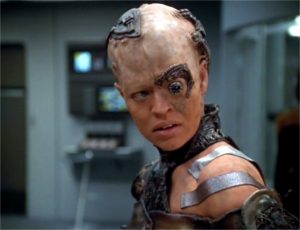I have to admit, Donna Haraway‘s “Cyborg Manifesto” – despite its shortcomings – wows me every time I read it. I am not sure if it is the fact that this text – so eloquently describing changes that seems so very real today – was actually written in the 1980ies, when none of the things that seem to make us cyborgs today were part of everyone’s everyday life. Or it might be the sheer amount of different ideas brought together and interwoven, from science fiction to Marxism to feminist theory. Could be this text wows me because its style is so radically different from the usual academic writing, because it dares to speculate, antagonize and call for action. Or maybe, because it does all of those things at the same time. If I look closely, I find that the argument is not all that clear and some twists seem out of place to me. I am not always sure, there is even such a strong conclusion in there. However, this texts achieves what good political theory – in my humble opinion – is supposed to do: it provokes thought and triggers the imagination. In fact, it sends me down a spiral of exciting new thoughts whenever I return to it.
Haraway introduces the cyborg as what she calls “an imaginative resource” (292). The cyborg is an image that stands for embracing what Haraway identifies as three “crucial boundary breakdowns” of the contemporary world — between human and animal, between animal-human (organism) and machine, and between the physical and the non-physical (293/4). She suggests this image in order to launch a criticism of feminist discourse that questions its very basis – the idea that there is something about being a woman that naturally binds women. according to her there “is not even such a state as ‘being’ female” (295). The contemporary self, she argues, is fundamentally fractured. She asks then, “what kind of politics could embrace partial, contradictory, permanently unclosed constructions of personal and collective selves and still be faithful, effective – and, ironically, socialist-feminist?” (297). This is usually where I associate the Zapatistas and the peculiar way the Zapatista discourse manages to connect different struggles without levelling out the differences. Of course, their inspiring example also teaches us about the possible limitations.
Having tackled the concept of identity, Haraway goes on to question the postmodern conception of “biopolitics” and argues instead to think of the contemporary self as being constructed within the “informatics of domination”. This kind of domination works not through division and the imposition of categories but through permanently dissolving them, by blurring all distinctions and thereby disabling the crude (post-)modern tool of resistance – identification. Coding and information processing (rather than categorizing and subjectivation) are the ways in which this domination manifests itself. In its most advanced form it can eliminate the natural unity altogether – when in microlectronics there is copies without originals (303) or, as we would say, the digital copy is indistinguishable from the original. This is evident not just in purely digital environments but also, for example, in genetically ‘identical’ beings such as clons or identical twins where there is indeed differences inscribed in the genes themselves (Casselmann 2008). Even the genetic code of a living breathing person may change over the course of their life. In other words, coding always means recoding and there is never a wholly identical copy. The process of communication transforms all information and negates the possibility of complete identity.
The cyborg as a resource for political imagination – how does that work in the informatics of domination? Haraway draws on literature in order to give her answer. I have a “literary” cyborg of my own in mind. In the Start Trek universe there is a race called the Borg
(clearly, not the most original of names). These Borg procreate by “assimilating” other species, making their “technological and biological distinctiveness” part of their collective consciousness. The Borg absorb difference and create a unified whole in which individual distinctions are denied in favour of a collective unity. They are awfully efficient and – needless to say – the ultimate villains of the liberal consciousness. In one installation of the franchise, a young female, designated Seven of Nine, (incidentally dressed in a very revealing costume for the rest of the series…) is “freed” from the collective. It turns out, however, that she cannot be fully re-transformed into a human – some cybernetic implants remain as well as – more importantly – many character traits. Throughout the series the character remains trapped between being Borg and being human, never fully emerging as one or the other. She struggles with defining and re-defing herself and there is no choice for her than to remain in between. Interestingly, the franchise offers many more of these characters – the robot “Data“, who looks so much like a human and interacts with humans like a human but lacks emotion like a radicalized version of a vulcan. The half-klingon B’Elanna. The holographic doctor with the complex personality subroutines. Outside the Startrek Universe we could consider the Terminator or Marvin, the paranoid android. If we think of their struggles not as ones that seek to cross the border between human and machine but rather as continuous struggles for acceptance of the lack of any clear boundary, we may find the inspiration Haraway sees in the image of the cyborg. Just like Seven of Nine can never be fully human nor return to be Borg, we may never be woman or man, German or European, white or black but only ever the something that struggles to cope with lack of clear distinction between these categories.
What sounds like a grim outlook may be the one strategies that alleviates the effects of the informatics of domination. As nothing is fixed, the domination is constantly challenged by the very mechanisms that maintain it. Resistance is not about overthrowing domination but about continuing to struggles along the lack of clear boundaries. It is about turning the struggle into the purpose. Maybe that is why Haraway ends on the optimistic note:
I would rather be a cyborg than a goddess. (316)
Tags: cyborgs, feminism, Haraway, imagination, technology




 Die
Die
Am 23. June 2016 um 16:55 Uhr
Thank you professor Höppner!
Itwould be very interesting to discuss in the class informatics of domination and diffused identity.
But… Isn’t a Borg itself a form of identity maybe, new, that we are not yet aware of? At the same time, in the se way, if we talk about socially constructed human nature, what protects identity from being socially constructed?
Am 23. June 2016 um 18:00 Uhr
+ the issue of expansion of the concept of labor, when some of the traditional female “to do” things were incorporated, and this influenced the approach to gender identity. There can be a linked made to the analogous set of robots, cyborgs, role of their labor, and our construction of identity. May be I am wrong.
Am 24. June 2016 um 09:05 Uhr
A Cyborg with the name Haraway appears in the sci-fi anime Ghost in the Shell 2 – innocence, having a conversation about robots and human beings with a human being.
https://m.youtube.com/watch?v=S25YpTaowsU
Am 29. June 2016 um 15:25 Uhr
Nice link! Thanks!
Am 30. June 2016 um 19:55 Uhr
***Reading Haraway 15 years after***.
As I did not open my mouth the other day (for reasons not related with the text) permit me a comment here.
I read science, cyborgs and women at the beginning of the XXI century. On that time, was not only this text indeed, but specially “the promise of mosters” (that I read in a seminar) who touch us the most.
That was the time in which the utopia internet was still exploding: the net as a promise land where everything could be possible: from self organization to gender dissolving. A time in which the relation between feminism and technology built in the 70 and 80 as a relation of “hope”,even if already questioned as domination techniques of the body, was still ongoing.
We were already on a time of non unitarian subject of political struggles, but exploring the meaning of it.
The role of imagination on Haraway´s cyborg proposal opened up the possibility to rethink all the categories with which we use interpretat the world. New political subjects, as infinite and open recombinations.
It was the time to think the net (and its ambivalence: social resistance and systemic shape of late capitalism), the time of new political aggregations, the time of global (also on that time, globalization was the big topic, the frame for new political proposals, including Zapatism)
It was inspiring, it was usefull: the way we undestand our reality was radically changed.
But what remains years after?
A couple of years ago, a friend (a woman who works, thinks and acts through computers and networks) propose to a small group of friends to try on organizing a discussion group about ciberfeminism: the idea was to review, from the so called “internet utopia” of the ´90s what had changed since then, and of course, one of the references, was Haraway. We didn´t do it due to other reasons, but I think the proposal is still relevant: The informatic of domination have dramatically developed, but somehow, the political figurations such as the cyborg are still useful. How this field of internet operates as a field of struggles and at the same time as a strong mechanism of reproduction and subjection, and how we relate with it.
There is an author (Remedios Zafra) that has been working on this topic for the last ten years. Her first book called “netianas” was written in 2005 (netianas, a kind of cyborg, a political figuration). After that, she wrote “a conected room of one´s own. (Cyber)space and (self) management of the self” about the definition of private space on a connected world and the process of subjectivity and identity on the net, how we build the self but also a possible “we” on the net. She has other books after that (but I guess that is the only translated one by now). Her last book is called “eyes and capital” and is from 2015, exactly ten years after the first, in which she added a short chapter at the end, that reflect about the imaginative figure called “netiana”, about time and conected lifes after that time and all its changes on our way to live in the net. She does it, lets say, in a less “utopian” way.
Re-reading Haraway is always wowing as Ulrike posted. But it is interesting for me to read through these changes, specially because the most important ones, take place in our own eyes: our way to look and understand the world. And Haraway´s text is a precious tool for that different gaze wich is indispensable to think in a different way and imagine a different world.
Connecting with the last post: In my opinion, the change of epoch and the interaction with technology has dramatically affected our relation with time, for example. And also, in the construction of the self, as Ulrike propose on the last post: for example the way young people built their identity on the net, the use of images that make them “exist”, like the “selfi” phenomenon or the use of social networks in which we can analyze the question suggested at the end of the last post “the thing about doors”.
See you tomorrow.
Ana
Am 16. February 2023 um 22:21 Uhr
Hello fu-berlin.de webmaster, Your posts are always well presented.
Am 26. February 2023 um 14:44 Uhr
To the fu-berlin.de administrator, Your posts are always informative.